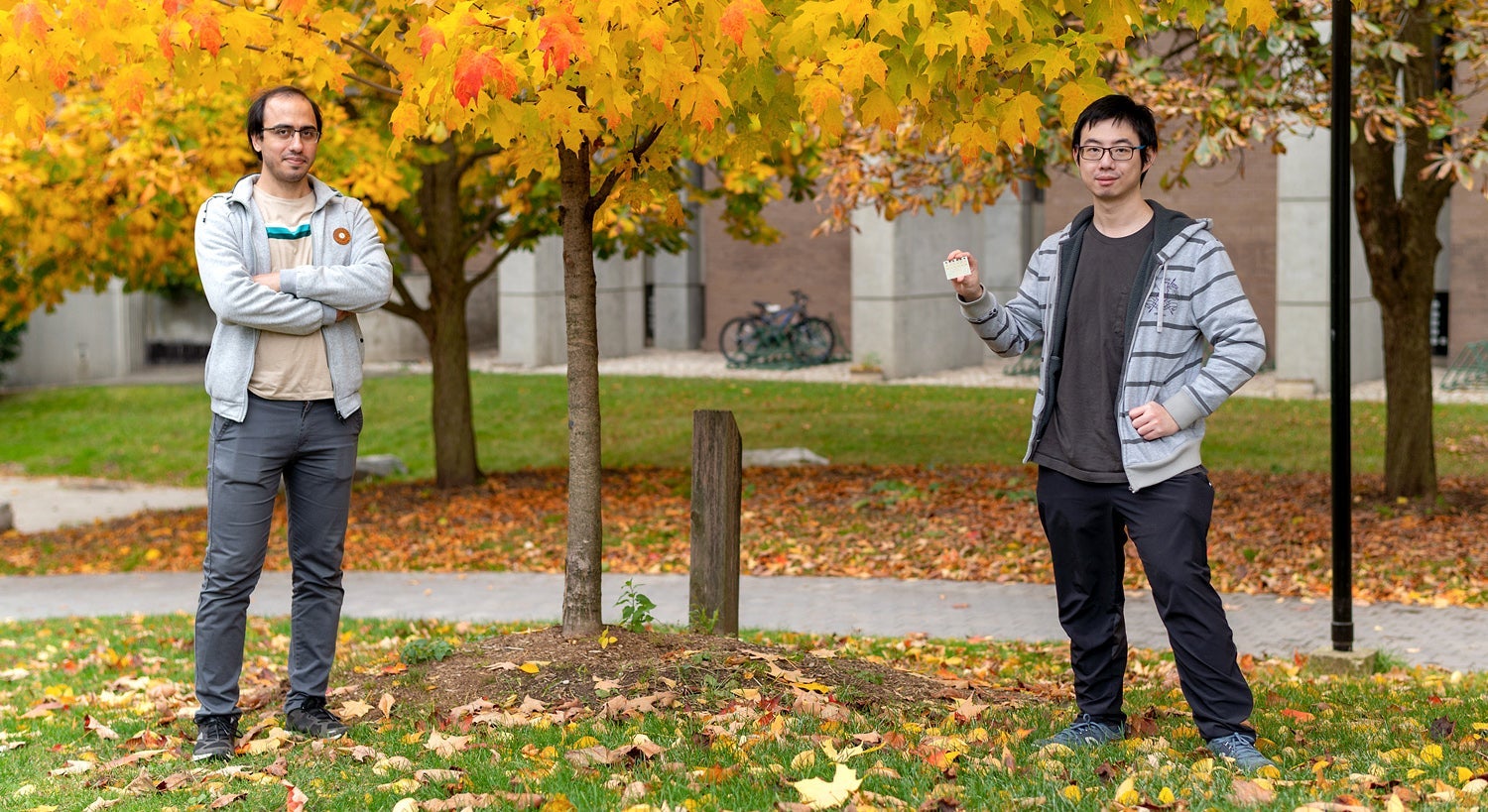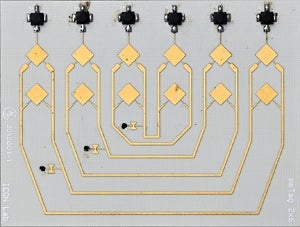The main difference between current wireless networks and 5G networks comes down to two words — speed and latency.
5G networks are expected to be up to 100 times faster than current networks. And at that speed, 5G drastically cuts latency when connecting to the network, the lag between instructing a computer to perform a task and its execution. One thing we know with certainty — by delivering mountains of data at warp speed wirelessly, the impact of 5G will be enormous and it will be felt across all sectors of society.

Left
to
right:
Cheriton
School
of
Computer
Science
postdoctoral
researcher
Mohammad
Mazaheri
and
master’s
student
Alex
Chen,
who
holds
the
mmTag
device.
Mohammad
Mazaheri
designs
mmWave
networks
for
high-speed
and
versatile
Internet-of-Things
applications.
His
research
focuses
on
reducing
energy
consumption
to
make
them
suitable
for
portable,
user-friendly
devices.
Alex
Chen
is
a
master’s
student
and
Cheriton
Graduate
Scholar
supervised
by
Professor
Omid
Abari.
His
research
explores
new
uses
of
mmWave
technology,
in
particular
mmWave
devices
that
enable
road
sensing
in
self-driving
cars.
“5G networks are arguably the most consequential network of the 21st century,” says Computer Science Professor Omid Abari. “5G achieves high connection speeds by using what’s known as mmWave technology. Wi-Fi devices and the current 4G LTE networks use 1 or 2 GHz signals, but 5G uses 28 or 60 GHz signals to communicate. These mmWave signals are orders of magnitude higher in frequency and using such high frequencies is precisely what enables 5G to have orders of magnitude higher throughput communications.”
Unfortunately, there’s no free lunch. If you use very high frequency radio signals to connect devices wirelessly the cost is increased power consumption. But where some may see that as an inescapable price to be paid, others see it as a challenge to overcome.
“We wanted to see if we could design a mmWave network that has very low power consumption,” explains Mohammad Mazaheri, a postdoctoral researcher at the Cheriton School of Computer Science who works with Professor Abari. “If we achieve that, we would significantly lower the power consumption of 5G networks and eventually enable 5G devices with power consumption so low that maybe they wouldn’t even need a battery to operate.”
To do this, Professor Abari, Mohammad Mazaheri and master’s student Alex Chen created mmTag, a mmWave 5G device that uses low-power backscatter technology to achieve gigabit per second data rates.
Backscatter technology itself isn’t new and it’s used in a wide range of low-power applications. Whether a simple device such as RFID tags that are used to keep track of inventory in a factory or a store, or more sophisticated Wi-Fi backscatter devices for Internet-of-Things applications, all backscatter devices are passive. Instead of using a power supply to generate and transmit data using radio frequency signals, backscatter devices piggyback their data passively on the radio signals of other devices. They do this by reflecting a modulated radio signal back to the transmitter. But despite their energy benefit, current backscatter networks have low data rates, a best about few megabits per second.

The mmTag is tag fabricated on a printed circuit board. The device’s dimensions are 60×45 mm2. Field effect transistors are used for the radio frequency switches, which cost about 60 cents. They are the only mmWave component used in the tag, making the design low cost. mmTag is tuned to cover the whole 24 GHz mmWave band. The current prototype of the tag is small, and includes six antenna elements, which create a directional reflector. This design can be tuned to higher frequency bands, which would allow for even smaller antennas.
While backscatter technology is not new, what mmTag has accomplished using backscatter technology is new. “Our mmTag uses backscatter technology that operates in the mmWave spectrum band, enabling 5G high-throughput wireless communications, and it does this while keeping energy requirements low,” explains Alex Chen.
Using mmWave frequencies in backscatter networks must first address a fundamental challenge known as beam alignment that’s common to all 5G communications. 5G uses high frequency signals and such signals drop off quickly with distance. To get around this problem, 5G networks use directional antennas that focus the transmitted and received radio signals into narrow beams.
“Usually we use active components called phase shifters to steer the beams to align them between the transmitter and receiver,” Mohammad Mazaheri explains. “But phase shifters consume a lot of power and at mmWave frequencies they have even higher energy costs. If we’re going to use backscatter technology, we can’t use such active components. We solved this using a different technique called passive beam forming, which is done by connecting the antennas to each other with passive transmission lines. The antennas reflect the beam in the direction it arrived at the antenna array, so there’s no need to search for the transmitter or to find the best direction. This technique automatically aligns the beam without any processing and without consuming power for beam forming.”
The data rates the mmTag prototype achieves are truly impressive for a passive device — mmTag can provide 1 gigabit per second data rate at a distance of about a metre and 10 megabits per second at three metres, hundreds of times greater than what existing backscatter networks achieve at similar ranges.
“At the moment we are using a simple data modulation scheme,” Alex Chen says. “The antennas in the mmTag are either reflecting the signal or absorbing the signal — sending data as a big zero or as a big one to the transmitter.”
“We have only scratched the surface of what’s possible,” adds Professor Abari. “Our next goal is to use a more complex data modulation and a different passive antenna arrangement to increase both the data rate and range.”
Gigabit per second rates will be essential for a host of new applications such as wireless augmented and virtual reality glasses. Such high data dates would also enable networked medical devices, perhaps tiny implanted probes to sense biometric data in the body for disease monitoring and diagnosis — in essence, any application that requires a high data rate and low power consumption at close range.
“We are building these 5G technologies now and they might not have an immediate or perfect application this moment,” said Professor Abari. “But in a few years, we will see many applications that require high data rates but not high range. We know these applications will come. mmTag shows that we will be able to make them a reality.”
To learn more about this research, please see Millimeter Wave Backscatter: Toward Batteryless Wireless Networking at Gigabit Speeds, which was presented virtually at HotNets 2020, the 19th ACM Workshop on Hot Topics in Networks, November 4–6, 2020.